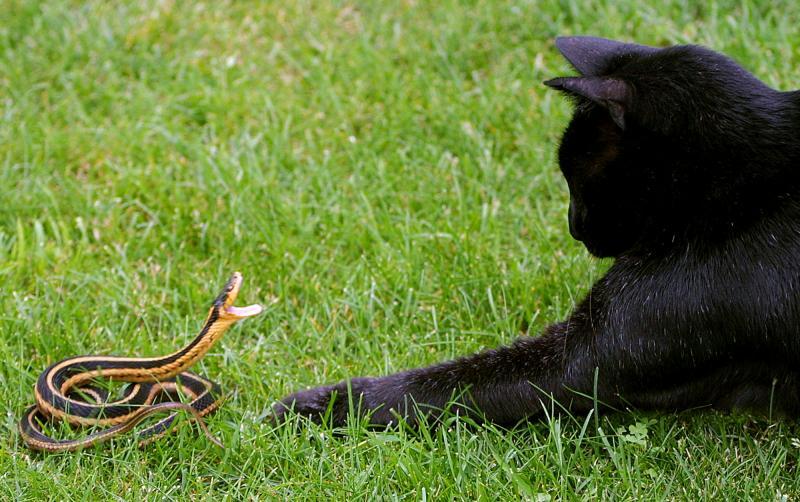QUESTION: I sure hope you can help me. I am having an awful problem with cats in my flower bed. I have tried everything: pepper, mothballs, shaved soap, cayenne pepper, egg shells, fine chicken wire under the earth, rhubarb leaves boiled in water and put around the flowers, pellets, which are very expensive. If you can help me, I would really appreciate it. I am a senior and the garden means a lot to me. Thank you.
Leona, Winnipeg
ANSWER: The main reason that cats are attracted to gardens is because they look and feel like the perfect place to, shall we say, go to the bathroom. Exposed soil is just like kitty litter, so putting in additional plants to cover soil and covering exposed areas with pebbles or a thick bed of prickly roses or some cacti or chunky mulch around the perimeter of your yard and in your gardens is your first step. Of course, all cats are not the same, and what works for one may not work for another. The most effective remedy against cats in the yard is a fence, but that is not always an option. Another tidbit to keep in mind is that cats loathe snakes. For years, gardeners have had great success when placing artificial snakes around plants. Check out your local dollar store or cut up an old garden hose the length of snakes and put them around the yard.
If you happen to catch a cat in your yard, spray them with a spray bottle or a garden hose and accompany that with a firm "NO!" Some cats love water, but most hate it. Cats have a sense of smell 14 times greater than humans. They are able to decipher odours that humans cannot even detect. Therefore, planting rue, lavender, lemon, thyme and coleus are also options. Lastly, consider commercial-scent cat repellents such as Shake Away.
QUESTION: What would you recommend using to remove old paint from wood? I don't want to refinish the piece, just remove the paint. Is there a product that will do this? Thanks.
Eileen, Winnipeg
ANSWER: Your easiest solution is to lightly sand any paint drips with 0000 steel wool and a good furniture wax. Pick a colour that matches your piece and wipe the wax along the grain until all the paint is gone. If the paint is on a polyurethane-coated wood surface, use cotton swabs dampened with acetone to remove the paint residue, as the polyurethane will resist acetone (test on a small, inconspicuous area first). Or make a soft paste of rottenstone and linseed oil (for oil finishes) or lemon oil, and rub gently along the grain using a soft cloth and a small amount of paste. Follow paint removal and remove the paste residue with a light overall cleansing using the soft cleaner you typically use on your wood finish. Harsher chemical strippers can also be used according to the manufacturer's instructions to address persistent stains. Follow with an overall cleansing to remove any residual stripper. You may need to refinish the piece.
QUESTION: Love your column, love your books -- I always find interesting and useful tips for my home. My question for today is, I recently got my ears repierced after about 30 years and am just tickled! I currently have little studs in my ears, but want to "graduate" to wearing hoops. Do you know of an environmentally friendly/non-allergenic way to clean silver hoops? (I originally gave up earrings because I was allergic to them.) I don't want to start off on the wrong foot again. I appreciate your feedback! Look forward to hearing from you!
Cynthia, Winnipeg
ANSWER: Here are a few easy ideas for cleaning your silver earrings: For weekly cleaning, soak the earrings in a bowl of 25 per cent sea salt and 75 per cent water. For monthly cleaning, line the bottom of a bowl with a sheet of aluminum foil and fill the bowl with warm water. Add a generous amount of salt, about four tablespoons, and a squirt of liquid dish soap. Place tarnished jewelry on top and you'll see the tarnish begin to disappear, a natural chemical reaction that actually magnetizes the tarnish right off. No buffing or rubbing needed. Wipe clean and dry with a terry towel.
If you do notice your ears becoming itchy or irritated, you can coat the posts with clear nail polish. If the itchiness persists, either change earrings or take your earrings to a jeweller and have the posts replaced with surgical steel or hypoallergenic posts.
QUESTION: Two years ago, we moved into a house in Linden Woods. It was apparent that the lawn was in desperate need of maintenance, and we have worked hard over the last two summers to improve the condition of the lawn. One of the problems that continues, and seems to be getting worse, is the noxious weed quack grass. We have applied new topsoil over the grass, use a 28-3-3 granular weed 'n' feed twice a year, and mow the lawn regularly using a mulching mower. Our lawn space is large, as we are on a corner lot and maintain the boulevard space as well. The quack grass has also infiltrated the perennial gardens. I have noticed that quack grass is a problem on most private and city lawn spaces in this neighbourhood. Any suggestions you have would be most appreciated!
Dawn, Winnipeg
ANSWER: Quack grass is one the most troublesome perennial grassy weeds in our lawns and it is more complicated to control than other weeds. Many weeds can be controlled with selective herbicides -- ones that kill specific plants and leave all others unaffected. Unfortunately, there is no selective herbicide available to control quack grass in lawns. To control quack grass chemically, a non-selective herbicide is required. A non-selective herbicide will kill all growth it contacts, which means you would have to get rid of your entire lawn and start again. For most people, this is not an option. Your best option is to dig out quack grass, making sure that all rhizomes are removed, because even a small section left in the ground can renew growth.
Although it takes a lot of work to get rid of quack grass, you can control it by mowing your lawn at the lowest setting on your mower. Soak the areas affected by quack grass and wait until the quack grass is five inches long (it grows faster than regular grass). With gloves on, soak large sponges with weed killer and press the sponge onto the weed. Make sure that you touch only the areas that you want to kill. Three days later, the quack grass will die off. Fertilize and water the lawn.
Fabulous Tip of the Week:
For pets that have been sprayed by a skunk, bathe the animal in a mixture of one quart (one litre) of three per cent hydrogen peroxide, one-quarter cup (60 millilitres) baking soda and one teaspoon (five mL) liquid dish soap. After five minutes, rinse the animal with water. Repeat if necessary. The mixture must be used up after mixing and will not work if stored for any length of time. Extra tip: 50/50 vinegar and water are not as effective, but may also be used; be sure to avoid the face. (Taken from Household Solutions 2 with Kitchen Secrets)
I enjoy your questions and tips -- keep them coming!
Check out my website: www.householdsolutions.org
Reena Nerbas is the author of the national bestsellers, Household Solutions 1 with Substitutions, Household Solutions 2 with Kitchen Secrets, and the brand-new Household Solutions 3 with Green Alternatives, available online and in stores across Canada.




